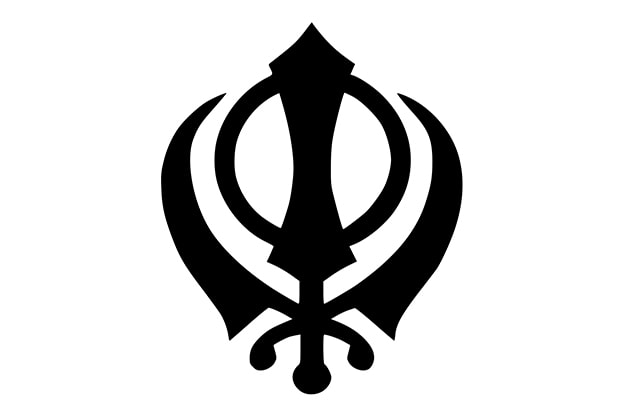
The Khanda is arguably the most common and popular Sikh symbol. It represents the four pillars on which the Sikh faith is anchored. This article examines the use of the symbol in the Sikh faith.
Origin
The exact origin of the Khanda symbol remains unclear. However, various accounts posit that the original Khanda was used by Guru Gobind Singh when he stirred up the waters of baptism in towards the end of the 17th century (1699). Speculatively, it could be as old as the Sikh belief system itself. When considered in light of the symbolism that the symbol carries, it is with little shades of doubt that any other origin may not be considered for the foreseeable future. What is obvious is the use of the symbol carrying the rich content of the Sikh faith. Just as the cross is to the Christian believers, so is the Khanda to the Sikh faith adherents.
Description & Use
As has been mentioned, the Khanda is the official symbol of the Sikhs. In the same way the Star of David is to the Jews, the symbol carries and represents weighty doctrinal renderings of the faith. The symbol bears the fundamental architecture o to which the Sikh believe is founded, built and perpetually sustained.
The Khanda, for the start, derives its name from the two edged sword which can bee seen at the center of the symbol. The sword’s name is the Khanda and it represents the perspicacity with which the sword is able to actively separate lies from truth. The incisive nature of the symbol is believed to stand for Divine Knowledge which is able to sieve and filter lies from truth. There is a circle that further encompasses the sword (Khanda). This is called the Chakar and it signifies the Ek On Kar. This capitalizes on the characteristics of any given circle such that it has not traceable beginning or end. This is indicative of the perfect and eternal nature and Oneness of God. Simply translated, the Chakar simply mean a wheel. The name closely resembles a similar one which refers to the medieval weapon used in similar contexts to emphasize the unity of God. It represents the Divine manifestation as the Absolute. It is also indicative of the Immortal nature of God who is forever Just and One. The Chakar was in fact worn by Sikh warriors as recently as the 18th century just as the Nihangs are still speculated to wear it.
To the exterior of the Chakar, stand the two carved Swords. These are called the Kirpans. Under the Sikhism belief, the two curved swords denote the concepts of Meeri and Peeri (alternatively referred to as the miri- Piri). While the former bespeaks of temporal authority, the latter places emphasis on the spiritual authority as first explained and — actually used — by Guru Hargobind. These two thematic concepts place the onus of spiritual well being matching the physical and societal progress for any true Sikh. Further, this also emphasizes that both the spiritual and the temporal sovereignty must not be considered as separate entities, but rather perceived as integrated. Much like the application of the Yin and Yang in the Chinese mythology, the Kirpans are designed to impart a sense of conceptual balance to the whole arrangement.
The symbol is also used together with the Nishan Sahib (the flag that can be seen flying outside every Sikh temple, the Sikh Gurdwara). In this arrangement, the sword weapon (Khanda) is placed at the top of the Nishan Sahib and used as a finial. In some instances, such as on the flag, the Khanda symbol can be seen at the center of the flag.
The use of the sword (Khanda) signifies the following: first, the right edge signifies freedom and authority but within the definition and confines of spiritual and moral authority of the faith.
The left edge, on the other hand, indicates the ruthless justice with which oppressors are chastised.
Conclusion
The Khanda is a symbol that represents enormous doctrinal positions and beliefs of the Sikh faith. Besides explaining the idea of realities and the Oneness of God, the Symbol expounds the fundamental teachings of the Sikh as being accurate and true.

